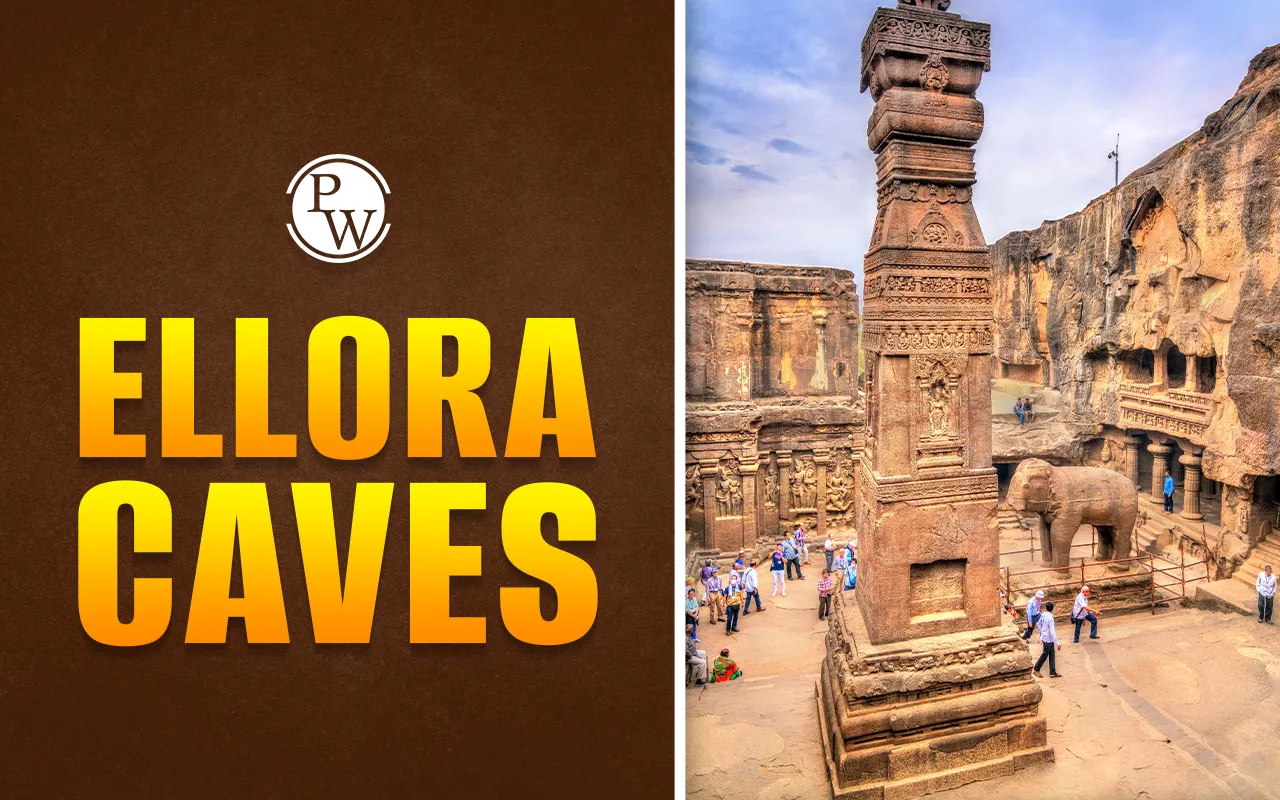
Ellora Caves are located in the Sahyadri range of Maharashtra in the Aurangabad district. It was designated as a UNESCO World Heritage Site in 1983. These sets of 34 caves were built between the 5th and 11th centuries AD by various guilds of Vidarbha, Karnataka, and Tamil Nadu.
Ellora Caves reflect natural diversity in their style of architecture and themes. The most significant cave is Cave no. 16 or the Kailasanatha Cave, named after the mountain in the Kailasa Ranges of the Himalayas, which is considered to be the home of Lord Shiva.
The Ellora Caves stand as a witness to three great religions in India, namely Buddhism, Jainism, and Brahmanism. Out of the 34 caves present there, 17 are Brahmanical, 12 Buddhist, and 5 are Jain Caves.
The Brahmanical Caves are located at the centre and represent a fusion of architectural styles, including Dravidian and Nagara traditions. They reflect the patronage of dynasties such as the Chalukyas and the Rashtrakutas.
The Buddhist Caves have several images from the Vajrayana Buddhism, including Tara, Mahamayuri, Akshobhya, Avalokiteswara, Maitreya, and more. Buddha, being the central figure, is found in three sagacious postures, namely, Dhyana Mudra, Vyakhyana Mudra, and Bhumi-Sparsha Mudra.
The Jain Caves are the newest and are situated at the northern-most end of the complex. The 5 caves are dedicated to the Digambara Sect of Jainism and feature intricate sculptures of Tirthankaras and Jain deities. The caves represent Jainism’s core principle of non-violence and self-help.
Both Ajanta and Ellora Caves are situated approximately 100 km apart from each other in the Sahyadri Ranges of Maharashtra. Both of them are magnificent rock-cut cave complexes and have been listed under the UNESCO World Heritage Site since 1983.
The Ajanta Caves consist of 29 rock-cut caves known for their beautiful Buddhist paintings. There are carved into a horseshoe-shaped cliff along the Waghora River.
These caves feature some of the finest surviving examples of ancient Indian art and including vibrant frescoes and sculptures depicting stories from the Jataka Tales and the life of Buddha.
Ajanta Caves are believed to have been created in two phases, first during the 2nd century BC, and second during the reign of the Vakataka dynasty in the 5th century AD.
Ellora Caves primarily stand as the symbol of religious harmony in Ancient India. The 34 caves are dedicated to three different religions.
Ajanta Caves are famous for their paintings, whereas the Ellora caves are more known for their sculptures and monuments. All the caves are carved from top to bottom, representing a remarkable achievement of engineering.
There are 34 caves created in Ellora that belong to three different religions. Each of the caves has its own significance. But some caves become prominent over the years due to their architectural styles and themes. Some of the prominent Ellora Caves are mentioned in the table below:
| Prominent Ellora Caves | |
| Caves Numbers | Details |
| 10 |
|
| 12 |
|
| 14 | Ravan ki Khai Cave |
| 15 | Dashavatar Temple |
| 16 |
|
| 29 | Dhumar Kena Caves |
| 30 | Chhota Kailash (Jain Caves) |
| 32 | Indra Sabha (Jain Caves) |
| 33 | Jagannath Sabha (Jain Caves) |
Apart from the Ajanta and Ellora Caves, there are numerous other rock-cut and other types of caves created in ancient India. These caves were dedicated to various types of sects and religions and represented the religious harmony existing in those. Several rulers and dynasties over time became patrons of these caves. Some of the prominent caves of ancient India are mentioned in the table below:
| Other Prominent Caves of Ancient India | |
| Caves | Details/Features |
| Elephanta Caves | located on Elephanta Island near Mumbai, and was originally a Buddhist site, later dominated by the Shaivite faith. |
| Bagh Caves | located on the banks of the Baghni River in the Dhar district of Madhya Pradesh, and is a group of nine Buddhist caves |
| Junagadh Caves | A unique feature is the presence of a 30-50 ft high citadel known as ‘Upar kot’ in front of the prayer hall |
| Mandapeshwar Caves | Developed in the late Gupta period as a Brahmanical cave, and was later converted into a Christian cave. |
| Udaygiri Caves (MP) | Located in Vidisha, Madhya Pradesh, and created in the early 5th century AD under the patronage of Chandragupta II |
Want to learn more about India, its culture, and sports for UPSC? Explore PW’s UPSC Courses and get faculty guidance for your preparation!

UPSC Coaching